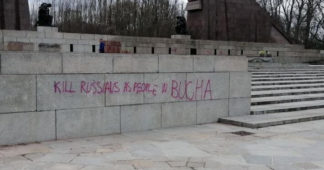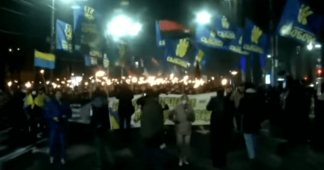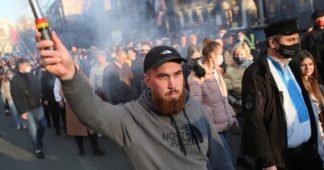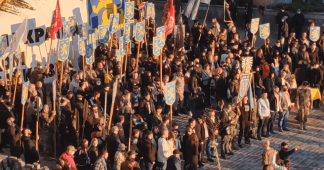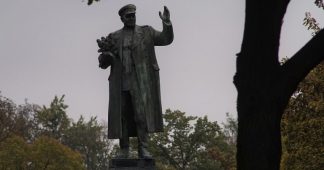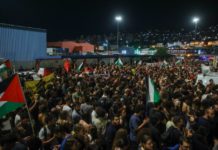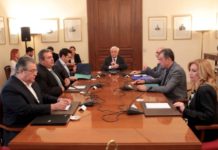By Maxim Goldarb
Mar 8, 2023
Head of the “Union of Left Forces of Ukraine – For New Socialism” party in Ukraine which opposes the NATO war against Russia and has been banned and persecuted by the Zelensky government.
80 years ago, in 1943, Kiev, the capital of Ukraine, was liberated from Nazi occupation by troops of the Red Army, led by General Nikolai Vatutin.
Shortly after the liberation of Kiev, General Vatutin died as a result of a wound inflicted on him in an ambush by Ukrainian Nazi collaborators from the OUN—the Organization of Ukrainian Nationalists. In 1944, he was buried in one of the central parks of Kiev that he had liberated, and a monument was erected on his grave with the inscription: “To General Vatutin from the Ukrainian people.”
The general was deservedly considered a hero; flowers from the people of Kiev always lay at his monument.
And now, in our days, in the year of the 80th anniversary of the liberation of Kiev, the monument to Vatutin was demolished. With this demolition, the Kiev authorities also desecrated his grave.
The destruction of monuments to the soldiers of the Red Army, which liberated Ukraine and Europe from fascism, is going on throughout Ukraine. In some cities, such as Chernivtsi, Rivne and many others, they are demolished, and in some places they are completely blown up, as happened, for example, in Nikolaev.
In addition, many other monuments are being demolished: monuments to the Russian poet Alexander Pushkin, to the writers Nikolai Ostrovsky and Maxim Gorky, the test pilot Valery Chkalov and many others.
Moreover, in recent years, cities, villages, streets and squares have been massively renamed in Ukraine.
Since February 2014, after the coup d’état during the Euromaidan, more than a thousand settlements and more than 50,000 streets have been renamed in Ukraine.
Last year alone, 237 streets, squares, avenues and boulevards were renamed just in Kiev, as the city’s authorities, headed by mayor Vitaliy Klitschko, proudly report. The same government, which for nine years since 2014, when Klitschko first became mayor, could not build in Kiev, a city of 3 million people with constant traffic jams on the roads, a single new metro station, a single new multilevel transport interchange, a single new medical center, a single new campus, a single waste processing complex, and so on.
Where did such an insistent desire to rename everything and everyone come from? Is it because a large number of local residents wanted this? Because they were suddenly no longer satisfied with the names of the cities and streets, where they themselves, their parents, and sometimes grandparents were born and raised? Nothing of the sort. There were no referendums, no votes of local residents on these issues, no one asked their opinion.
On the contrary, in the few cases that polls were conducted, they almost always showed their overwhelming disagreement with the renaming. For example, in the case of the renaming of the regional center Kirovograd a few years ago, which had been named so almost 90 years ago in honor of the famous Soviet statesman Sergei Kirov, the absolute majority of the city’s population—82 percent—did not support the decision to rename the city to “Kropyvnytsky”. Only 14 percent supported it.
But neither in this case, nor in any other of the many cases when monuments were demolished and streets renamed did the authorities care at all about the opinion of the citizens.
Why then is all of this happening? The answer to this question becomes clearer if you look closely at the new names and monuments that are now being erected.
The avenue of General Vatutin, who helped liberate Kiev from Nazism, which was discussed at the very beginning of the article, was renamed to the avenue of Roman Shukhevych, a Ukrainian fascist. A the time of the attack of Nazi Germany on the Soviet Union in June 1941, Shukhevych served as a member of the Nachtigall battalion, a subdivision of the Abwehr (the military intelligence of the Wehrmacht), which consisted of Ukrainian Nazi collaborators.
What was formerly “Moscow Avenue” in Kiev was renamed to the Avenue of Stepan Bandera—another Ukrainian Nazi collaborator, and leader of the OUN (b), the Organization of Ukrainian Nationalists, which during the Second World War “became famous” for its collaboration with the German Nazis, and its genocidal massacres of the Polish and Jewish population.
There are now many monuments erected and streets named in honor of Bandera in cities throughout Ukraine.
The Druzhby Narodov Boulevard in Kiev was renamed into the Mykola Mikhnovsky Boulevard. Mikhnovsky was one of the main ideologists of Ukrainian nationalism, the author of the chauvinistic slogan: “Ukraine is for Ukrainians!”
And the street named after the Soviet military leader, Ukrainian Marshal Malinovsky, one of the leaders of the Red Army during the war against Nazism, was named the Street of the Heroes of the Azov Battalion. The Azov Battalion is a neofascist paramilitary formation that is now an official part of the Ukrainian army. Its emblem is the “wolfsangel,” a notorious Nazi emblem that has been used by units of the Nazi SS, in particular. For those who did not know or forgot, let me remind you that Azov was recognized as a neo-Nazi and terrorist group even by the US Congress.
The current government in Ukraine is completely destroying everything that is somehow connected with Russia, which most of Ukraine was part of for hundreds of years—even monuments and streets that were named in honor of world-famous writers—like Leo Tolstoy. It is also destroying everything that is related to the 70-year-old Soviet period in the history of Ukraine, and with socialism and leftist ideology in general. For example, streets named after Karl Marx and Friedrich Engels have been renamed, monuments to them have been demolished, socialist and communist symbols—from the red flag to the performance of the “Internationale’—are prohibited. Likewise, all left-wing parties are banned in Ukraine, including the Union of Left Forces – For New Socialism, which I head.
Socialism and communism are banned, left-wing activists are persecuted and imprisoned, and neo-Nazism is becoming an element of state policy and increasingly the dominant ideology.
This all-out war by the Ukrainian authorities against all public symbols, monuments and names that are associated with Russia, the October Revolution and Soviet history, or leftist ideology, requires a lot of money.
The cost of just one plate with a new street name for one house, according to the Kiev authorities, is at least 1,000 hryvnia (about 25 euros). This must be multiplied by the dozens (and sometimes hundreds) of houses on the same street. And then this must be multiplied by the tens of thousands of streets that are being renamed. Let me also remind you of more than 1,000 renamed cities and villages.
But the cost of the new address plates is only a small part of the enormous costs of this right-wing campaign. There are many more components. All institutions and enterprises have to change documents, order new seals and stamps, update signs at the entrance, and so on. We need new signs on the roads, entrances to the settlement, as well as for streets and roads throughout Ukraine. Many institutions—not only in the renamed cities but throughout the country—need to be provided with new maps and atlases.
For instance, the renaming only of the city “Zhdanov” to “Mariupol” cost about 24 million euros. According to the most conservative estimates, the massive wave of street renaming and the demolition of monuments throughout the country has already cost more than 1 billion euros!
And this is in the most impoverished country in Europe, and during a war at that! This is in a country which is now in critical need of financial assistance and 60 percent of whose state budget revenues this year are provided by funding from abroad, mainly from the EU and the United States.
This means that the money of European and American taxpayers is now being spent, among other things, on the mass renaming of streets in Ukraine in honor of Nazi collaborators and neo-Nazis.
I don’t think most citizens of the “donor” countries would agree with this. But it seems that they, like most citizens of Ukraine, are not going to be asked for their opinion.
We remind our readers that publication of articles on our site does not mean that we agree with what is written. Our policy is to publish anything which we consider of interest, so as to assist our readers in forming their opinions. Sometimes we even publish articles with which we totally disagree, since we believe it is important for our readers to be informed on as wide a spectrum of views as possible.
